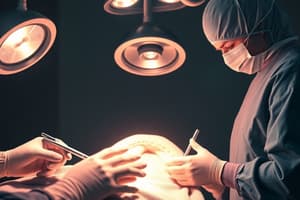Podcast
Questions and Answers
What is the primary goal of modern hernia repair techniques to minimize recurrence?
What is the primary goal of modern hernia repair techniques to minimize recurrence?
- Aggressive mobilization of the ilioinguinal nerve.
- Meticulous suturing of the hernia defect under high tension.
- Simple identification and approximation of the hernia edges.
- Tension-free closure using mesh reinforcement. (correct)
Which of the following structures is NOT explicitly mentioned as requiring preservation without mobilization during an open inguinal hernia repair?
Which of the following structures is NOT explicitly mentioned as requiring preservation without mobilization during an open inguinal hernia repair?
- The genital branch of the genitofemoral nerve.
- The iliohypogastric nerve.
- The ilioinguinal nerve.
- The femoral nerve. (correct)
What is the typical orientation and length of the initial skin incision in an open anterior inguinal herniorrhaphy?
What is the typical orientation and length of the initial skin incision in an open anterior inguinal herniorrhaphy?
- Obliquely oriented incision of 4-5 cm.
- Midline incision of variable length.
- Vertically oriented incision of 10-12 cm.
- Transversely-oriented, slightly curvilinear incision of 6-8 cm. (correct)
During dissection in an open inguinal hernia repair, after incising the external oblique aponeurosis, what is the next critical step regarding nerve management?
During dissection in an open inguinal hernia repair, after incising the external oblique aponeurosis, what is the next critical step regarding nerve management?
How does a direct inguinal hernia present anatomically during surgical exploration?
How does a direct inguinal hernia present anatomically during surgical exploration?
What anatomical plane is entered during the initial dissection after incising the skin and subcutaneous tissue?
What anatomical plane is entered during the initial dissection after incising the skin and subcutaneous tissue?
What is the primary reason for avoiding aggressive mobilization of the ilioinguinal and iliohypogastric nerves during hernia repair?
What is the primary reason for avoiding aggressive mobilization of the ilioinguinal and iliohypogastric nerves during hernia repair?
A patient is found to have both a direct and indirect inguinal hernia during surgical exploration. What is the correct term to describe this type of hernia?
A patient is found to have both a direct and indirect inguinal hernia during surgical exploration. What is the correct term to describe this type of hernia?
Flashcards
Tension-free hernia repair
Tension-free hernia repair
Surgical repair focused on closing the hernia defect without undue strain.
Traditional hernia repair
Traditional hernia repair
Previous methods of simply suturing the hernia closed, which led to high recurrence rates.
Shouldice repair
Shouldice repair
A technique involving meticulous dissection and closure, achieving low recurrence rates without mesh.
Initial incision location
Initial incision location
Signup and view all the flashcards
External ring
External ring
Signup and view all the flashcards
Iliohypogastric and Ilioinguinal nerves
Iliohypogastric and Ilioinguinal nerves
Signup and view all the flashcards
Indirect inguinal hernia
Indirect inguinal hernia
Signup and view all the flashcards
Direct inguinal hernia
Direct inguinal hernia
Signup and view all the flashcards
Study Notes
- Successful hernia repair relies on tension-free closure of the defect for minimal recurrence rates.
- Earlier methods of simply suturing the defect resulted in recurrence rates as high as 15%.
- Current techniques involve placing mesh over or behind the hernia defect to enhance repair.
- The Shouldice repair is an exception, achieving low recurrence rates through careful dissection and closure without mesh.
- Tension-free closure leads to reduced postoperative pain and discomfort.
Open Inguinal Hernia Repair
- Begins with a 6-8 cm transverse, slightly curved skin incision, positioned one to two fingerbreadths above the inguinal ligament.
- Dissection proceeds through the subcutaneous and Scarpa’s layers.
- The external oblique aponeurosis is identified, with the external ring located inferomedially.
- The aponeurosis is carefully incised and opened along its length through the external ring using fine scissors, while avoiding nerve injury.
- The iliohypogastric and ilioinguinal nerves are identified and preserved without mobilization to prevent post-herniorraphy inguinodynia.
- The genital branch of the genitofemoral nerve should be identified and preserved without mobilization in order to retain their protective investing fascial layers.
- Soft tissue is cleared from the posterior surface of the external oblique aponeurosis on both sides, and the spermatic cord is mobilized.
- The cremaster muscle fibers are separated from the cord structures using blunt and sharp dissection to isolate the cord.
Hernia Anatomy
- An indirect hernia presents with a sac attached to the cord in an anteromedial location, extending superiorly through the internal ring.
- A direct inguinal hernia appears as a weakness in the floor of the canal, posterior to the cord.
- A pantaloon defect involves both direct and indirect defects within the same inguinal canal.
Studying That Suits You
Use AI to generate personalized quizzes and flashcards to suit your learning preferences.




